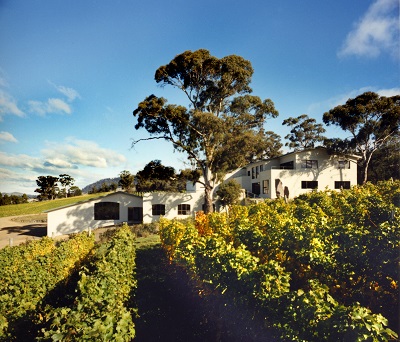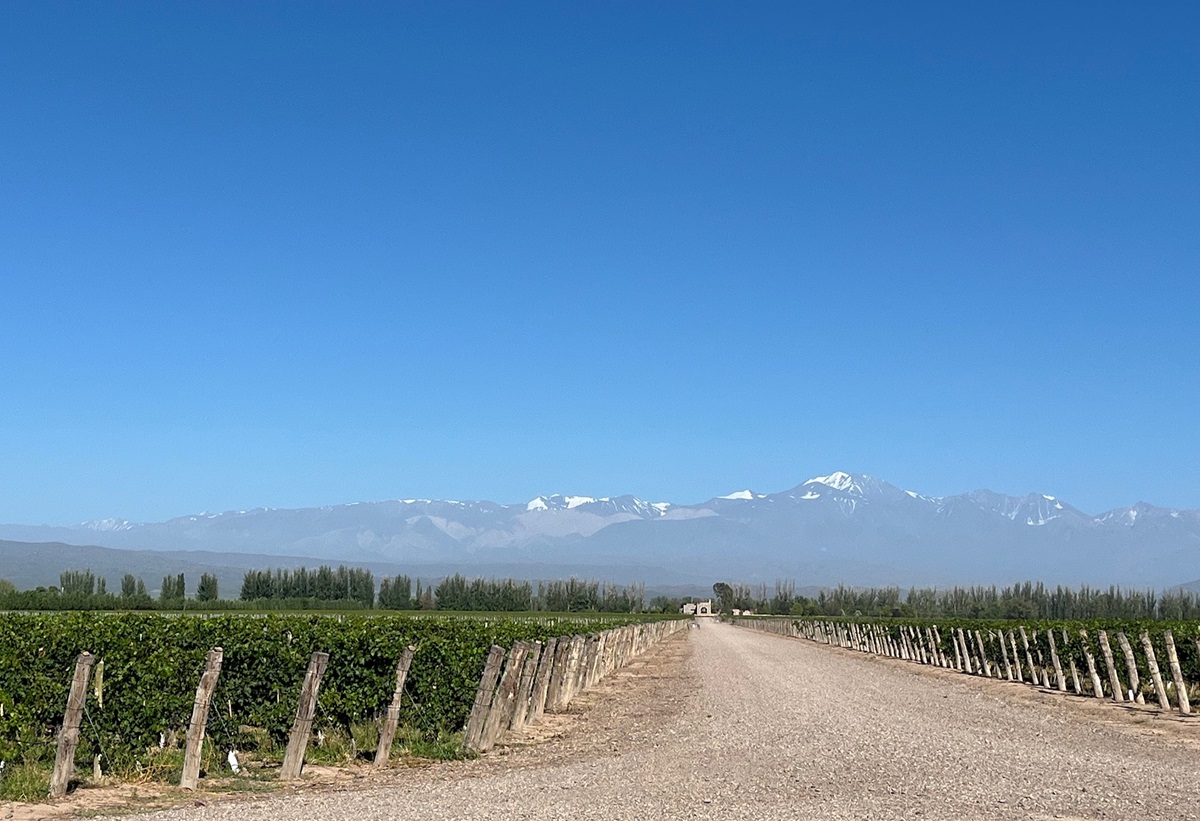TASMANIA: THE APPLE ISLE

by Rose Murray Brown MW
Published in The Scotsman August 2014
The apple of Australia’s eye is currently a small island which is often left off their map. Picturesque quaint Tassie is a well-known tourist destination, but it has until recently been considered a risky place to grow grapes.
Known as the Apple Isle, Tasmania supplies the world with Braeburns and Granny Smiths, but its cool maritime climate also attracted prospective winemakers. To date it has only been small family wineries who have braved the chilly westerlies here. But as temperatures edge up in mainland Australia with harvests earlier and droughts increasing, parts of Hunter or Victoria may become too hot, dry and expensive for vines in 30 years, so the big guns are setting their sights on this southerly outpost.
Until recently the big Aussie companies like Domaine Chandon and Hardy’s have plundered Tasmania to add acidic zip to their fizz, shipping juice and base wine 150 miles across the Bass Strait to the mainland to add to their blends. Yalumba have owned vineyards here for their popular Jansz fizz brand using Tassie grapes, made in Victoria. But in the last few years as reports have trickled out about climate change, there has been a sea change.
Big names are snapping up estates, taking advantage of relatively cheap land prices in cool windy Tasmania reputed to be ‘one tenth of New Zealand land prices’. Brown Brothers have bought Kayena, the Hill Smiths who own Yalumba now have three estates here including new purchases, Frogmore Creek and Dalrymple. Significantly, Brown Brothers have sold their 116 hectare White Hills winery to the huge Treasury Estates who make Penfolds Grange which will certainly put Tassie on the map.
Along with the apples, cherries, saffron and pears that Tasmania is known for, grapes are becoming an important crop. Popular fizz grapes Chardonnay and Pinot Noir are being joined by aromatic varietals for still wine like Riesling (‘the unsung hero’ still just 6% of plantings here), Pinot Gris, Gewurztraminer and Sauvignon Blanc. Experimentation in cooler northwest Devonport, previously considered too cool and wet, indicates the move to cooler spots.
Pinot Noir is the most planted red grape (35% of plantings) making a lighter and less alcoholic style than mainland Aussie Pinots, but pioneers are experimenting with warm climate red grapes like Shiraz and Cabernet Sauvignon in sheltered easterly Tamar Valley and Coal River.
This must all be music to the ears of one man, Dr Andrew Pirie. An academic with a mission, he singlehandedly revived Tasmania’s wine industry – setting up Pipers Brook winery in 1973. I remember first meeting him in the late 1980’s and was struck by this determined energetic passionate young man who had so much belief in this quaint island – at a time when his wine colleagues were focusing on more important issues in Hunter or Barossa.
Pirie now works for the largest winery, Tamar Ridge, and attracts international investors to the island. He has just returned from Champagne hoping to convince the Champenois that Tasmania is a good place to invest for fizz: currently 40% of Tassie’s grape production is used for sparkling.
Vines on Tasmania are nothing new. First planted in 1821 in New Town in capital Hobart’s suburb, in 1848 a Tassie white won a prize at the Paris Exhibition – but vineyards all but disappeared here until the 1950’s. Today there are 1,600 hectares, less than 1% of Australia’s vineyard area. Out of 260 vineyards, only 28 producers own more than 10 hectares, so production is small, yields restricted by coastal winds, everything is done by hand – and wine prices are high.
Another pioneer, Peter Althaus (pictured), was considered by the wine world as crazy when this wealthy Swiss investor declared that he was going to grow Cabernet in southern Tasmania, in Coal River in 1989. He had searched the world for the right spot, declared no interest in New Zealand’s Central Otago and had settled on a tiny vineyard north east of Hobart which he says has the largest number of sunshine hours in Australia. I was astounded when I tasted his wines, much lusher and riper than I was expecting. Now admired for his foresight, his Domaine A wines (Domaine A winery pictured above) at £40 bt are the most expensive on the island. His Cabernet declared as one of Australia’s best.
Once considered a rank outsider, Tasmania has most to gain from increasing temperatures – but according to Pirie, the warming will be slower in Tasmania as it is cooled by prevailing westerlies. A place to watch!
TASMANIA TASTE TEST:
Sparkling Wines
JANSZ NV
£16 Lockett Bros, N Berwick
Arguably Australia’s best fizz; delicious biscuit yeasty character and balanced creamy fruits. Jansz rose fizz is good too.
JANSZ VINTAGE 2007
£20 Lockett Bros, N Berwick
A step up from non-vintage
White
THE SOCIETY’S TASMANIAN CHARDONNAY 2011
£14.95 www.thewinesociety.com
I have tasted the 2011 vintage of this wine made by Freycinet, but TWS have sold out and moved on to 2012. The last vintage was so crisply elegant with citric steely palate – more elegant than many Australian Chardonnays.
Reds
DEVIL’S CORNER PINOT NOIR 2009
£13.74 www.michaeljoblingwine.com; www.bablakewines.co.uk; www.hennings.co.uk
One of the more accessibility priced Tassie Pinots, it has a ripe roundness but a cool core which makes it seem weightless.
STONEY VINEYARD PINOT NOIR 2010
£25.99 Drinkmonger, Edinburgh & Pitlochry; Cork & Cask, Edinburgh; Lockett Bros, N Berwick
The second tier of Althaus wines, named after the vineyard he first bought. Beautifully made, soft, light and good length: shows what potential Tasmania has for pretty Pinot Noir.
STONEY VINEYARD CABERNET SAUVIGNON 2007
£29.99 Drinkmonger, Edinburgh & Pitlochry; Cork & Cask, Edinburgh; Lockett Bros, N Berwick
Don’t expect this to be like your favourite Classed growth claret or a Aussie Coonawarra Cabernet either. This is an extraordinary Cabernet. Pricey, but fascinating to taste in its ripeness and elegance.
DOMAINE A CABERNET SAUVIGNON 2006
£46 Alliance Wine www.alliancewine.co.uk
I was astounded when I tasted Peter Althaus wines. So ripe and mellow – benefitting from Domaine A’s policy of maturing wines in bottle themselves. He blends in a little Cabernet Franc and Petit Verdot too, Bordeaux style: very concentrated deep blend.
wine tastings
The perfect gift for the wine enthusiast in the family. Rose does In-person tastings too.
cellar advice
Rose does cellar valuations for private clients, valuations for insurers & bespoke portfolio management.
Related stories
March 31, 2024
By Rose Murray Brown MW Published in The Scotsman 30 March 2024 On 2 February 1659, the first wine made from grapes grown in South Africa was crafted by the Governor of the Cape, Jan van Riebeeck. He had planted vines four years earlier in the Company’s Garden near Cape Town from cuttings imported from France. Van Riebeeck’s first
March 24, 2024
By Rose Murray Brown MW Published in The Scotsman 16 March 2024 Heatwaves and bushfires were very much on the agenda when I visited Chile last month as winemakers prepared for their 2024 harvest in blistering heat and drought, with a plume of smoke from the devastating fires lingering over coastal hills. Heat and drought are the greatest challenges
March 23, 2024
By Rose Murray Brown MW Published in The Scotsman 9 March 2024 I have two glasses of Malbec in my hands from the same high-altitude vineyard in Uco valley in Argentina. I am in the Catena Institute of Wine in Mendoza with winemaker Agustin Silva. He has asked me to taste the two wines, both from the 1500m high



